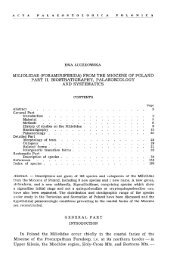Full text - Acta Palaeontologica Polonica
Full text - Acta Palaeontologica Polonica
Full text - Acta Palaeontologica Polonica
You also want an ePaper? Increase the reach of your titles
YUMPU automatically turns print PDFs into web optimized ePapers that Google loves.
344 ACTA PALAEONTOLOGICA POLONICA 56 (2), 2011<br />
Fig. 10. Species of the genus Amauropsina Bayle in Chelot, 1885, under<br />
UV light. A. Amauropsina canaliculata (Lamarck, 1804), MNHN A30469<br />
(MNHN coll.), Grignon, Yvelines, France, Lutetian, in dorsal view.<br />
B. Amauropsina canaliculata (Lamarck, 1804), MNHN A30468 (MNHN<br />
coll.), Grignon in ventral (B 1) and dorsal (B 2) views. C. Amauropsina<br />
canaliculata (Lamarck, 1804), MNHN J02165 (Cossmann coll.), Grignon,<br />
in dorsal view. D. Amauropsina canaliculata (Lamarck, 1804), MNHN<br />
A30467 (MNHN coll.), Grignon, in apical (D 1) and dorsal (D 2) views.<br />
E. Amauropsina arenularia (Vasseur, 1882), MNHN A30465, Villliers−<br />
Saint−Frédéric, Yvelines, France, Lutetian, in ventral (E 1) and dorsal (E 2)<br />
views. F. Amauropsina arenularia (Vasseur, 1882), MNHN A30471<br />
(Vaquez coll.), Saffré (Bois−Gouët), Loire−Atlantique, France, Bartonian,<br />
in apical (F 1), ventral (F 2), and dorsal (F 3) views. Scale bars 10 mm. Photo−<br />
graphs by C. Lemzaouda and P. Loubry (MNHN).<br />
intraspecific variability in the density and coalescence of the<br />
patches. The coalescence sometimes produces fluorescent<br />
sinuous axial segments (Fig. 10D).<br />
Amauropsina arenularia (Vasseur, 1882)<br />
Fig. 10E, F.<br />
Stratigraphic and geographic range.—Middle Eocene, Lute−<br />
tian–Bartonian (PB, Loire−Atlantique).<br />
Colour pattern description.—This species exhibits three lev−<br />
els of residual colouration. The background is dark and ho−<br />
mogeneous. The apex is pale and there are three spiral rows<br />
of fluorescent patches. The patches are variable in shape and<br />
they are axially and spirally aligned (Fig. 10E). A specimen<br />
from Saffré (Loire−Atlantique) displays some sinuous axial<br />
segments (Fig. 10F). Depending on the part of the shell, there<br />
may be only axial elongated sinuous segments or alternating<br />
elongated and short straight segments (Fig. 10F2). In the lat−<br />
ter case the two types of segments are sometimes connected<br />
(Fig. 10F3). Discussion<br />
Classification of the ampullinid colour patterns.—The<br />
different residual colour patterns can be organised into four<br />
distinct classes, each containing possible homologues in re−<br />
gard to the modalities of pigments incorporation during shell<br />
growth:<br />
– one to three spiral stripes or a wide fluorescent diffuse area<br />
(colour zonation of the background);<br />
– axial fluorescent zigzagging stripes;<br />
– axial, sometimes opisthocline, straight or slightly sinuous<br />
stripes or segments;<br />
– fluorescent patches sometimes forming axial segments<br />
through coalescence.<br />
Class I contains the most common patterns (Figs. 2–7)<br />
within the Ampullinidae and occurs in most of the genera ex−<br />
cept Pachycrommium (Figs. 8, 9). The survey of a large num−<br />
ber of specimens, particularly in the genera Ampullina and<br />
Crommium, shows that spiral stripes can diffuse and spread<br />
through ontogenesis, thus forming a wide diffuse area. We<br />
therefore include these two colour patterns in Class I. We be−<br />
lieve that they both result from variation of the background<br />
colouration.<br />
The three other Classes: II (Globularia including the ex−<br />
tant species), III (Pachycrommium), and IV (three species of<br />
Ampullina) are easily distinguishable and occur less com−<br />
monly within the Ampullinidae.<br />
Taxonomic implications of the patterns.—Class I: The re−<br />
sidual patterns of this class are very common within the<br />
Ampullinidae and also in numerous superfamilies of gastro−<br />
pods (e.g., Caenogastropods: Naticoidea, Cerithioidea, Litto−<br />
rinoidea, Muricoidea, Triphoroidea, Epitonioidea, Conoidea;<br />
Heterobranchia: Pyramidelloidea). They also occur in the Re−<br />
cent terrestrial Ampullarioidea, that have very similar overall
















